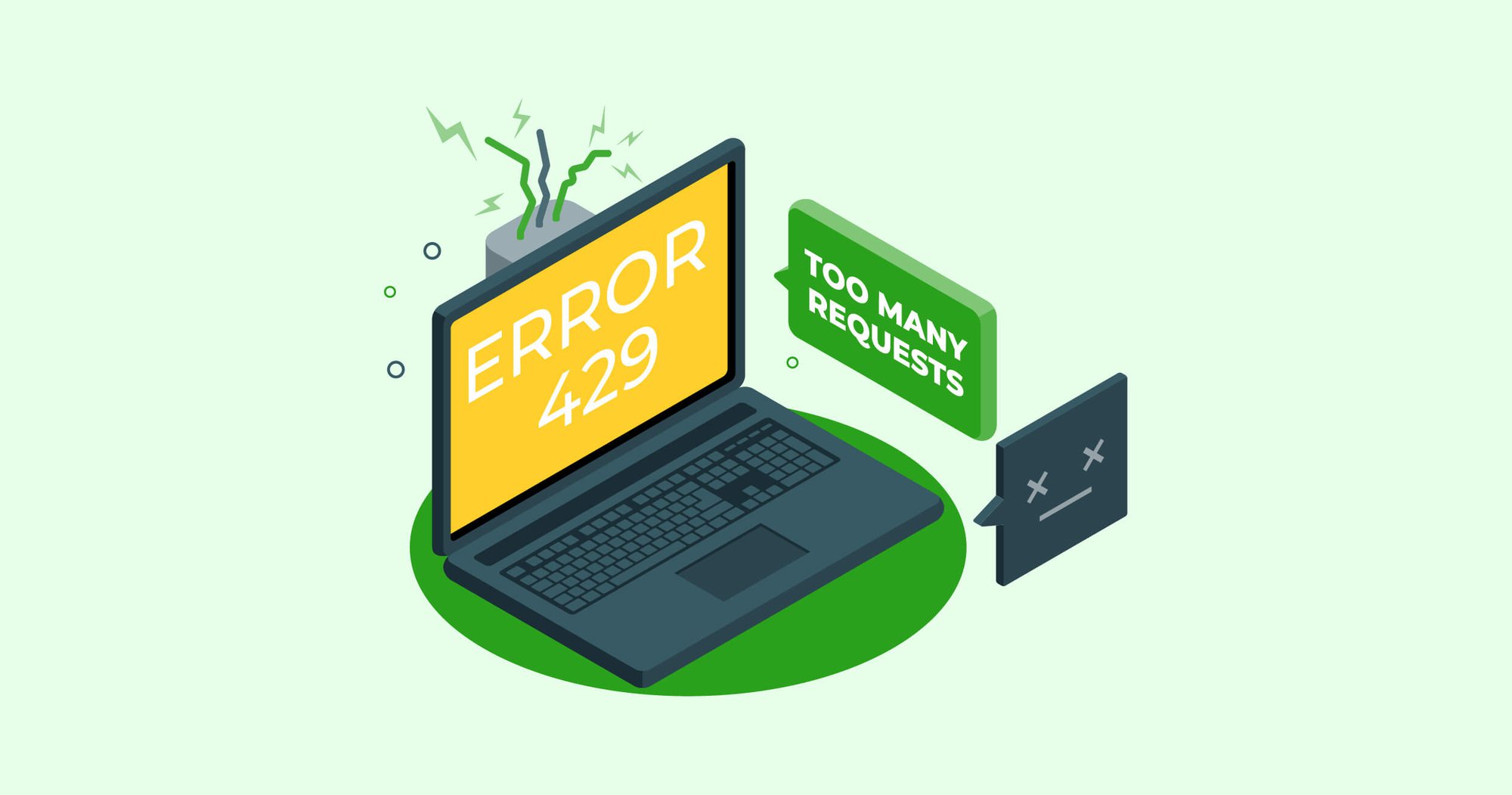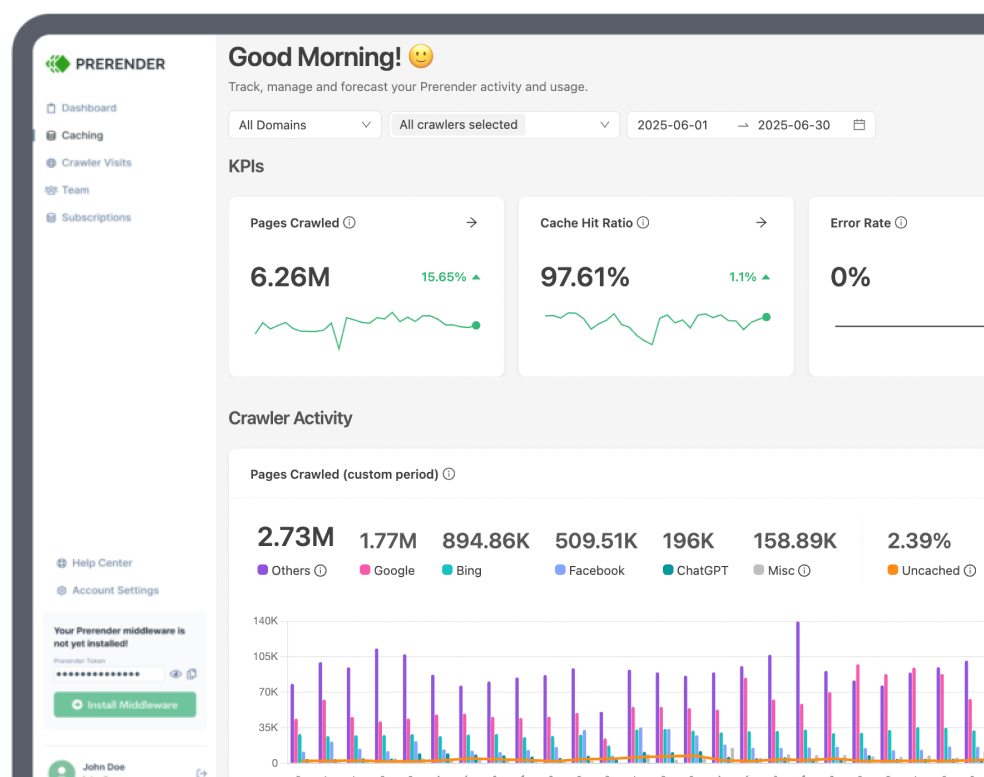429 Too Many Request errors are bad news. These errors often occur unexpectedly, blocking access for users or crawlers. For SEOs, particularly, it’s troublesome as frequent 429s interrupts crawling, wastes valuable crawl budget, and causes rendering problems that limit your visibility in search results.
In this article, we’ll break down what the HTTP 429 Too Many Requests error means, its correlation with rate limiting, and how you can troubleshoot and/or prevent 429 Too Many Requests errors.
What Are 429 Errors?
A 429 error, also known as the HTTP error 429 and 429 Too Many Requests error, is a status code sent by a website server when it receives more requests than it can handle within a certain period. In simple terms, it’s the server telling the client (a browser, API, or search engine crawler) to slow down

Every website interaction, such as loading a web page, fetching an image, or running an API call, counts as a server request. When those requests exceed the server’s request limit, the server may block further activity and return a 429 Too Many Requests error. So, for example, it can look something like this:
Googlebot attempts to crawl 300 pages in one minute, but your server only allows 100 requests per minute. The extra 200 requests will fail and Googlebot will receive 429 errors instead of content.
Why Are JavaScript Websites More Likely to Trigger 429 Too Many Requests?
Any site can hit web crawling limits, but JavaScript-based websites are more vulnerable to HTTP 429 errors. That’s because search engines don’t just fetch the HTML, they need to download and execute JavaScript, CSS, and additional API calls to fully render the page. This means that a single JavaScript page may require dozens of server requests, quickly stacking up against a website’s ‘rate limiting’ rules (explained later).
Without optimization, this creates rendering errors where crawlers can’t fully process the page.
Why Are 429 Too Many Requests Harmful for SEO?
When a server hits its request limit and starts returning 429 Too Many Requests errors, search engines like Google interpret it as a signal that the site can’t handle additional crawling. To avoid overloading the server, Googlebot automatically lowers its crawl rate.
This means that 429 errors can cause some serious SEO consequences:
- Your ‘crawl rate’ shrinks, meaning fewer pages are discovered.
- Indexing delays occur, so content updates or new content take longer to show up in search results.
- Some pages may never be indexed at all.
In short, persistent HTTP 429 errors lead to SEO crawling errors and page rendering issues that hold back your visibility on SERPs and in AI search.
Not familiar with ‘crawl rate’ and how it ties into ‘crawl budget’? Understanding this connection is key to improving your indexing and long-term SEO performance. Learn more about crawl budget in this free ebook.
What Are the Common Causes of 429 Errors?
If your site frequently shows the HTTP error 429, it usually means the server is hitting its request limit.
Here are the most common causes:
- Aggressive crawling from search engine bots (Googlebot, Bing bot); often triggered when new content is published or after a sitemap update.
- Scraping attacks as bots try to scrape your content, product pricing, product descriptions, etc.
- DDoS protection, such as Cloudflare blocks bursts of requests even if they come from legitimate crawlers like Google.
Particularly for JS-heavy websites, like ecommerce, these are the triggers of the 429 Too Many Requests error:
- High request volume per page load
A single JavaScript-based product page might trigger dozens of requests (HTML shell, JavaScript, CSS, APIs). This is double or even triple the request volume of processing a simple HTML page.
- JavaScript rendering delays
Since processing JS content requires multiple requests, a 429 error may stop the process, delaying your content from being indexed.
- Rate-limited API
Many ecommerce websites rely on APIs to provide inventory and shipping rate data, or personalization offerings. These can quickly exceed API rate limiting rules, resulting in 429 Too Many Requests errors.
- Infrastructure limits
Smaller ecommerce servers may not be able to handle the high volume of requests from crawlers and bots, leading to 429 errors and page rendering issues.
What is Rate Limiting?
Rate limiting is a traffic control mechanism that restricts the number of requests a user or bot can make. For example, a server might allow only 200 requests per minute per IP address. Once this limit is exceeded, the server responds with a 429 error.
Rate limiting helps servers manage traffic, protect resources, and prevent abuse, ensuring that site performance remain stable.
Did your traffic drop suddenly, and you don’t know what caused it? Here’s how to fix a sudden drop in traffic.
429 Errors vs. Rate Limiting: What’s the Difference?
While rate limiting is the process a server uses to control traffic, the 429 error is the signal you receive when you exceed those limits. Think of it like a highway: rate limiting is the speed limit, and the 429 Too Many Requests error is the ticket you get for going over it.
What Are the Common Causes of Rate Limiting?
Since a 429 Too Many Requests error occurs when request limits are hit, the causes of rate limiting often overlap with it. These include sudden traffic surges, high request crawling, and high API usage.
Consequently, rate limiting can lead to page rendering errors, web crawling limits, and SEO crawling errors, which may affect your site’s visibility and performance.
How Rate Limiting Impacts SEO and Page Discoverability
- Google reduces crawl rate
Rate limiting can cut search engine crawlers off before they complete their work. As a result, some pages may never be discovered or re-crawled, impacting overall site discoverability. And since many AI search platforms, including ChatGPT and Gemini, are still mainly rely on search results as their data source, if your content doesn’t show up on Google SERPs, it may not never be picked up by AI crawlers to be suggested on AI search results.
- Incomplete indexing
For JavaScript-heavy pages, Google must crawl and render the content to fully understand it. If rate limiting interrupts this process, Google may treat your page as broken or incomplete, reducing its SEO potential.
- Your content takes a long time to show up on SERPs
Google fetches JS content in two waves: Wave 1 retrieves the HTML, and Wave 2 renders the JavaScript. If rate limiting blocks Wave 2, your content may experience delayed indexing (or worse, be skipped entirely), affecting search rankings and discoverability.
Learn more about how Google indexes JavaScript content and its implications on JavaScript SEO here.

How to Troubleshoot HTTP 429 Errors
Encountering a 429 Too Many Requests error can disrupt page indexing and hurt SEO, but identifying the root cause and adjusting limits can resolve it efficiently. Here’s a step-by-step approach.
Step 1: Identify the Request Source
Start by checking your server logs or analytics to determine who is making the requests. Are they search engine crawlers, scraper bots, or real users? Are multiple requests coming from the same IP address?
Focus on distinguishing legitimate traffic from malicious activity, such as scrapers. Correctly identifying the source helps you maintain normal traffic while blocking harmful requests.
Learn more about how to distinguish bot vs. human traffic.

Step 2: Check Your Rate Limit Settings
Review the rate limiting rules on your web server, CDN, or API gateway. For instance:
- Nginx: limit_req_zone
- Apache: mod_ratelimit
- Cloudflare, AWS, or Akamai: built-in rate limiting rules
Ensure your limits are appropriately configured for your traffic patterns, allowing legitimate crawlers like Googlebot to index your site without hitting the server request limit.
Step 3: Reproduce the Issue
Use tools like curl or Postman to simulate requests at different rates. Check whether rate limits are applied per IP, per user, or per endpoint. This helps you identify bottlenecks and fine-tune limits without blocking normal traffic.
How to Prevent 429 Too Many Requests (Strategies and Tools)
There are several strategies to reduce the likelihood of 429 Too Many Requests errors, especially for websites supported by server-side rendering.
1. Adjust Rate Limits
If your server can handle more traffic, consider raising rate limit thresholds. Apply different rules for humans, bots, and APIs:
- Human requests: real users rarely hit limits because interactions are manual (clicks, scrolls, etc.). You can safely increase tolerance. For example, 100 requests per minute.
- Bots (crawlers and scrapers): whitelist legitimate search engine crawlers like Googlebot to prevent interruptions to your crawl budget. For scrapers, apply strict limits (such as 10 requests per minute per IP) to protect server resources.
- APIs: APIs are often heavily rate-limited. You can allow higher thresholds (e.g., 1,000 requests per hour) while combining this with Clear 429 + Retry-After headers so clients know when to back off.
2. Use Page Caching
Cache static assets to reduce direct server hits. When SEO crawlers request pages, caches can respond instead of your origin server, lowering the risk of hitting server request limits. Proper caching also improves page speed and overall user experience. Read this guide to learn more about the best caching practices.
3. Adopt Prerender.io for JavaScript Prerendering
Prerender.io smartly process incoming requests to your website and serves 100% indexed ready to content to search engines. This ensures search engines can quickly read, index, and rank your pages efficiently without overloading your server.

How Prerender.io Prevents 429 Errors
Prerender.io intercepts all requests to your website, including both search engine crawlers and human users. Here’s how Prerender.io works and its usage benefits:
- Request identification: human traffic is sent to your server, while search engine crawling requests are handled by Prerender.io.
- Caching JS content: Prerender.io converts JavaScript pages into cached HTML. Googlebot receives this cached version, reducing the risk of 429 Too Many Requests errors.
- Preserve crawl budget: by handling crawler traffic, Prerender.io minimizes server load, allowing requests to be processed and ensuring Google can crawl, render, and index your most important content.
This approach not only prevents 429 errors and hitting rate limit, but also supports SEO crawling efficiency, ensuring all your web pages is loved by Google and AI search platforms.
Watch this video to learn more about how Prerender.io works and its impact on SEO and AEO.
Avoid Getting 429 Errors and Hitting Rate Limiting with Prerender.io
429 Too Many Requests errors can disrupt page crawling and indexing, block search engine crawlers, and hurt your SEO performance. These errors often occur when traffic exceeds your server’s request limit, whether from aggressive crawlers, scrapers, or high API usage.
The good news is that 429 errors are preventable. By monitoring traffic sources, adjusting rate limits, and implementing caching, you can significantly reduce the risk of hitting your server’s limits.
For JavaScript-heavy websites, Prerender.io offers a simple, effective technical SEO solution. By serving 100% ready-to-index versions of your content to search engines, Prerender.io ensures your page processing activity won’t overload your server. This safeguards your SEO performance.
If you want to protect your site from 429 errors while improving indexing and page rendering for search engines, try Prerender.io today and see how effortless managing your JavaScript SEO can be.
Other SEO troubleshooting guides that may interest you:
- How to Fix 404 Errors on SPAs
- What Are Soft 404 Errors and How To Fix Them (5 Easy Ways)
- How to Fix ‘Discovered – Currently Not Indexed’ Google Indexing Issues
FAQs About 429 Too Many Requests Error Code and Rate Limiting
1. Does 429 Too Many Requests Hurt SEO and AI Search Visibility?
Yes. Search engine crawlers may interpret your pages as broken or unresponsive. As a result, it takes weeks for them to show up on SERPs or place in a lower ranking than their potential. Over time, repeated 429 errors can affect how much of your site is discovered and ranked, hurting your SEO and AI search performance.
2. Why Am I Seeing 429 Errors While Using Prerender.io?
If you see 429 errors on your web log while using Prerender.io’s free plan, it likely means you’ve reached your monthly rendering limit. When this happens, any requested pages won’t be processed, and instead, a 429 “Too Many Requests” response will be returned. To resolve this, you can either upgrade your plan or wait until your monthly rendering credits are replenished. Learn more about ‘How to Avoid 429 Error Codes with Prerender.io.’
3. How Does Prerender.io Keep My Site from Receiving 429 Errors?
Prerender.io serves pre-rendered HTML versions of your JavaScript pages to crawlers. This reduces the number of direct requests to your server, prevents rate limits from being hit, and lowers the risk of 429 errors. Prerender.io ensures search engines can effectively access and understand your content.
4. Can Prerender.io Handle Sudden Spikes in Traffic or Crawling?
Absolutely. Prerender.io caches rendered pages and serves them to crawlers and bots, which offloads traffic from your origin server. This prevents your server from being overwhelmed and reduces the likelihood of 429 errors during traffic surges or aggressive crawling.



